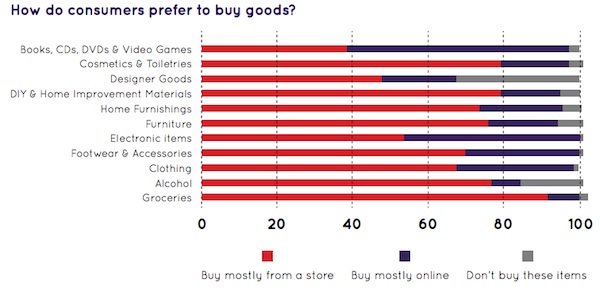In-store Retailers Struggle To Keep Up With Price Expectations Of Online Shoppers
Can ESLs provide in-store retailers with the ability to step-up to consumer pricing expectations?
Research conducted by Diplaydata surveying 2,000 U.S. and UK consumers, has revealed a growing trend in which consumers are “showrooming,” or browsing goods in-store before going online to compare prices and make a purchase. Thirty-two percent of the consumers surveyed said they engaged in showrooming in-store, using their mobile devices to check-out prices in store.
Other studies measured the showrooming figure to be closer to 40 percent, rising to an even greater 84 percent according to one Deloitte study when considering the number of shoppers who use their smartphones for research before heading into a store.
Digital experiences are exerting ever greater influence on consumer purchase journeys. The study estimates that an overwhelming majority, 97 percent, of consumers are now regularly shopping online, having become accustomed to the value and convenience that online shopping offers.
It’s easy to see why. Online retail benefits from the ability to change pricing based on supply, demand, or seasonal promotions, and so often is able to offer consumers better value. According to the report, Amazon, for example, makes 2.5 million price changes each day, while Walmart and Best Buy make around 50,000 price changes per month.
Consumers have come to trust in the value of online goods. The report reveals that 42 percent of U.S. shoppers still believe in-store retailers offer different prices online than they do in-store, and 72 percent have been discouraged from purchasing goods in-store because they were concerned the price was not good value.
Where Does In-Store Retail Fit In?
Despite this, there is still a strong case to make for in-store retail within consumer journeys. Displaydata’s survey found that 83 percent of U.S. consumers and 78 percent of UK consumers still make a large number of their purchases in-store.
In certain sectors, such as grocery, health and beauty, homeware, and DIY, the majority of consumer spending still takes place in a retail store, according to Displaydata:

Why are retail stores still so important to shoppers? Because consumers value:
- Seeing, touching, and trying goods.
- Taking advantage of in-store promotions.
- Asking questions easily.
In particular, the ability to see and experience items was considered by 75 percent of U.S. shoppers, and 80 percent of UK shoppers, to be the most important reason for visiting a store.
Why Integrate In-Store Retail Experiences With Online?
While some stores have introduced innovative strategies to link up online/offline consumer journeys, with a number of ecommerce retailers offering Click-and-Collect services to drive traffic in-store, there remains a disconnect between the expectations consumers have of brands as a result of the value and convenience they experience while shopping online, and that they receive in-store.
For example, 58 percent of shoppers are buying more goods on promotion than at the start of when shopping for groceries, an incentive that has become commonplace, if not the standard, for digital retail. If retailers want to connect up consumer journeys and reduce the drop-off from showrooming, they will need to introduce systems able to cater to consumer’s high expectations of convenience and value.
Introducing Electronic Shelf Labels
Click To Tweet
Displaydata’s report also espouses the potential impact of Electronic Shelf Labels (ESLs), which gives retailers the ability to adapt pricing and offer promotions to the effect online retailers have been able to offer consumers for years.
It’s a powerful proposition and one could bring real value to in-store retail operations. According to Patrick Connolly, senior analyst at ABI Research:
“[Electronic shelf labels] will give retailers far more control and flexibility, with the ability to reward loyal customers, dynamically match pricing to varying demand, while also meeting the needs of price sensitive customers.”
Retailers need to rethink in-store experiences and view them as consumers do. As a versatile resource that sits within an intertwining, omnichannel journey, able to provide a seamless user experiences with the rest of a consumers digital interactions. If they can bridge this gap between digital and physical shopping, then the distinction between online and offline brand offerings will work together, serving consumers in a manner independent of channels, but catering instead to the overall cohesion of the user experience.